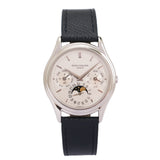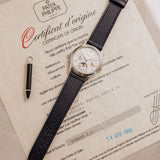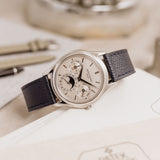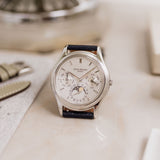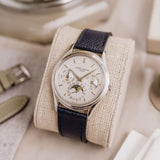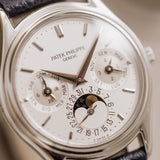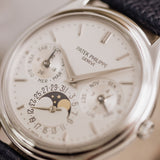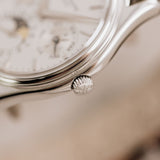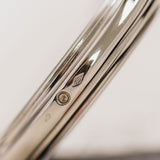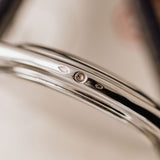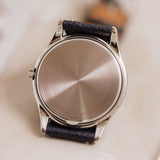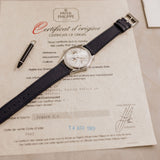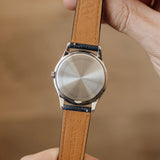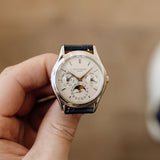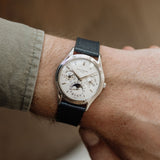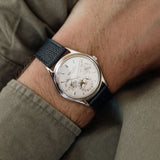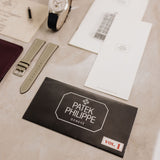Patek Philippe Perpetual Calendar 3940 Platinum - Early second series from 1989
Origin
Patek Philippe's standing is truly unrivalled. The Calatrava 96 from 1932 was a turning point for the manufacturer, becoming the defining blueprint for dress watches. The innovative, defying, and now ultra-desirable Nautilus from the 1970s was a pioneer. And with a mastery of complications to such a degree few watchmakers comprehensively compare, there are ample reasons why Patek is deemed the zenith of true serial luxury. But it's the latter that connoisseurs revere Patek for the most, and if there could only be one complication to embody their expertise as a maison, it would be the perpetual calendar; you only need to look at their lists of firsts to understand why. Such accomplishments include but are not limited to: the first perpetual calendar wristwatch (1925), the first perpetual calendar series (1941), the first self-winding perpetual calendar (1962), and the first perpetual calendar chronograph (1941). Patek continued its calendar distinction throughout the latter stages of the 20th century, and miraculously, as battery-powered time ticked over into the 1980s, their momentum continued.
In 1985, they debuted the 3940. Returning to three subdials for the calendar displays, 36mm sizing, an ultra-thin form, timeless dial features, and a micro-rotor powered calibre, the 3490 is still affectionately valued for its classical attributes. It's often seen as Patek's most significant reference in modern history. Furthermore, having been the watch of choice for Philippe Stern during his tenure as CEO (a position he vacated in 2009 to allow his son and still the current CEO, Thierry Stern to take the helm), it's easy to see why.
Over its 22 years in the Patek Philippe collection, it's believed 7,000 examples were produced, but of any given specific configuration, there is only a handful as it was highly segmented over the years by dial series, case metal, and dial executions. Initially only produced in yellow gold before rose, white, and platinum, the white metals are deemed the rarest configurations, with early platinum watches being scarcely uncovered.
For context, it is believed that only 600 examples of the 3448 (the model that predated the 3940) were created during its 20-year lifespan. During the 1980s, serial production of complicated Patek's had arrived, and the 3940 was the reference to usher it in.
The Watch
History tells us that the perpetual calendar is Patek Philippe, with the manufacturer first bringing the complication to the wrist in 1941, 14 years before a fellow Swiss competitor (Audemars Piguet) could in 1955. Patek Philippe has maintained a continuous production of the complication ever since, and in 1985, they released one of their most noteworthy watches, the 3940. Focusing on delivering classic fundamentals while perfecting the serial production of an ultra-thin perpetual calendar, it's considered by many as the first truly complicated serial timepiece and remains one of the most desirable modern Pateks ever produced.
Staying in the collection until 2007, the 3940 evolved through three defined series, with this particular example, the 3940P, being a rare instance of an early second series. Only produced between 1987 and 1989, the early second series editions carry a few key characteristics from the sans cross-hair leap year indicator seen on the later second series dials, as well as bevelled sunken sub-registers, a transition from the first series. But what makes this example even more significant is its platinum case, seldom seen in 20th century 3940s, let alone during the short 24-month run of the early second series. Most white metal examples from this era are white gold.
At a near-perfect 36mm, with a concave polished bezel, elegantly unassuming soft lugs, and a svelte profile, the 3940P bears the quintessence of classic watch case form. Purposefully minimalistic and eternally designed, the mid-sized platinum case is kept to a minimum, with just the recessed crown at three and the calendar advancer at nine o'clock. This vital watch component is flanked by two hallmarks that remain in fantastic condition. These stamps are sharp, deep, and clear – in instances that show signs of excess polishing, these hallmarks are typically the first part of the watch to suffer – here, its quite the opposite.
The balanced nature of the externals of the 3940P is accentuated tenfold by its dial. At its base, it's an opaline silver, adorned with white gold dial furniture and hands with the calendar readings in Italian (also deemed a rare variation). The devil is in the fine details with Patek, from the dot minutes and the applied dart markers around the periphery to the three registers with the moonphase at six and the recessed registers at three and nine. Governed by the dominant multi-faceted dauphine hands for hours and minutes before two heat-blued hands carrying honest oxidisation indicating the day and the month, the dichotomy between lavish opulence yet cultivated sophistication synonymous with Patek Philippe is abruptly apparent and underscored by this early platinum execution.
As the 3940P goes, this is one of the rarest editions of case material, dial series and dial language, made all the better by its immaculate condition.
The Movement
Powering this 3940P is the ultra-thin Calibre 240 Q. Based on the Calibre 240 developed during the 1970s, this perpetual calendar movement is a story in itself. Many people believed the base calibre was too thin for a perpetual calendar, yet Mr Philippe Stern proceeded with the project, proving naysayers wrong. Powered by an off-centred 22k gold micro-rotor, this 3.75mm thick calibre is beautifully hand-finished with Geneva striping, perlage, hand polishing and conservative anglage. Hidden behind a solid platinum caseback, it boasts a frequency of 21,600 vph and a running time of 48 hours.
How It Wears
The list of compliments paid to the 3940 over the years is close to endless, but the earnest is how the previous CEO chose the reference to wear every day. Out of all of the watches he could have worn, the 3940 came out on top year after year – and if that doesn't communicate how well the 3940 wears on the wrist and how practical it is, I'm not sure what will. It is smaller than more modern evolutions of the perpetual calendar, but at 36mm with a lug-to-lug of 43.3mm and a thickness of 8.5mm, it represents a real sweet spot of proportions.
Speaking loudly isn't behaviour the 3940 tolerates, as despite it being one of the most important Pateks to have been serially produced, its wrist presence is tastefully unassuming. Perfectly suited to a breadth of wrist sizes while remaining universal enough to excel on his or her wrist, this 1989 3940P is a particular riff on an already noteworthy creation.
Condition
As 34-year-old watches go, the condition of the 3940P is superb. As mentioned, oxidation can be seen on the blued hands, standing as the only signs that this watch is three decades old. The hallmarks are deep, and the condition is simply outstanding. The sale includes the pin pusher, Patek leather wallet, warranty papers signed 1989, certificate of origin, period correct leaflets, and the original Patek Philippe pin buckle in platinum. The watch is fitted to the Grained Midnight Blue Mr Watchley Strap.
If you desire to take a closer look at this precious timepiece, don't hesitate to contact us and make an appointment. We are based in Ghent, Belgium.
No stock is kept on site.
* Every watch is delivered in a Mr WATCHLEY Membrane Protection Box for a safe transportation in addition to its original set *
| Reference | 3940P |
|---|---|
| Movement | Automatic |
| Caliber | Calibre 240 Q |
| Dial | Opaline |
| Size (Case) | 36 mm |
| Material (Case) | Platinum |
| Bracelet | Mr Watchley grained midnight blue |
| Glass | Sapphire |
| Condition | Very good |
| Year | 1989 |
| Papers | Yes |
| Box | - |
| Warranty | 2 years |

